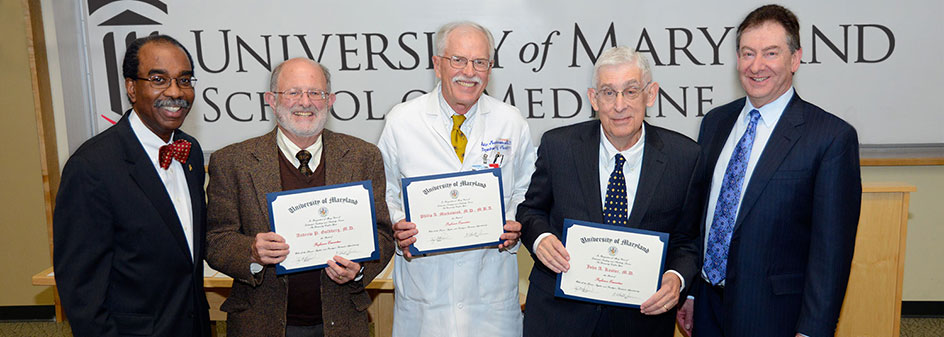June 23, 2021

Dr. Kastor receiving the honor of Professor Emeritus at a ceremony in 2015. Pictured left to right, Dean E. Albert Reece, MD, PhD, MBA, Andrew Goldberg, MD, Philip A. Mackowiak, MD, MBA, John A. Kastor, MD, and Stephen Davis, MD.
The Department of Medicine at the University of Maryland School of Medicine is saddened to announce the passing of former Chairman, John Kastor, MD. Dr. Kastor was recruited to the University of Maryland School of Medicine in 1984 and served for 13 years as the first Theodore E. Woodward Professor of Medicine and the 11th Chairman of the Department of Medicine.
A graduate of New York University School of Medicine, he continued there for his internal medicine residency and served as Chief Resident. Dr. Kastor did his cardiology fellowship at the Massachusetts General Hospital, then joined the faculty at the Hospital of the University of Pennsylvania where he served as Chief of the Cardiovascular Section prior to being recruited to Maryland.
Under his tenure, the number of full-time faculty members more than doubled, and the department's grant income grew from $3 million in 1984 to over $21 million in 1996, strengthening the Department’s and School of Medicine’s stature nationally. Dr. Kastor remained on the faculty, becoming Professor Emeritus in 2015. He continued his scholarly contributions, publishing his last article at age 82. Dr. Kastor is known nationally for his eight books and over 140 scholarly publications in the mechanisms, diagnosis, and management of cardiac arrhythmias as well as in the areas of academic medicine and governance of medical centers.
Throughout his career, Dr. Kastor’s specialty was cardiac arrhythmias, the irregular heart rhythms that medical researchers were just beginning to understand when he began his medical training. He was among the first generation of electrophysiologists who studied the electrical pathways controlling heart behavior. While learning to use a stethoscope in medical school, he discovered that he suffered from mitral valve prolapse, a condition in which the flaps in one of the heart valves do not close properly. After years spent studying arrhythmias, in 1992 he began suffering from atrial fibrillation, a condition he had treated in countless patients. He quickly diagnosed his own symptoms and walked down the hall from his office to the coronary care unit, only to find himself next to a puzzled and concerned patient he had seen only a few hours earlier.

Dr. Kastor was the founding Editor of the International Journal of Cardiology and more recently served as Editor of the Health Policy Section of the Alpha Omega Alpha publication, The Pharos. Late in his career, he wrote a series of books that explored the complex governance of academic medical centers. He based this work on careful research as well as numerous interviews with practicing physicians, university leaders, and public health officials.
“He brought new ideas to the university. He was a hardworking recruiter and was dedicated to building a top-notch department of medicine with a strong foundation in research, teaching and clinical care,” said Frank Calia, MD, Professor Emeritus of Medicine who served as the Vice Chair of the Department of Medicine under Dr. Kastor.
Dr. Kastor is survived by his wife of 67 years, Mae, their son Peter, daughter Elizabeth, 5 grandchildren and was predeceased by his daughter Dr. Anne Kastor.
“John Kastor will be remembered as a great builder and leader in the medical school,” said E. Albert Reece, MD, PhD, MBA, Executive Vice President for Medical Affairs, UM Baltimore, and the John Z. and Akiko K. Bowers Distinguished Professor and Dean, University of Maryland School of Medicine. "His compassion for his patients, extensive scholarship, and recruitment efforts helped established the stellar Department of Medicine he once led, and which continues to flourish today.”
About the University of Maryland School of Medicine
Now in its third century, the University of Maryland School of Medicine was chartered in 1807 as the first public medical school in the United States. It continues today as one of the fastest growing, top-tier biomedical research enterprises in the world -- with 46 academic departments, centers, institutes, and programs, and a faculty of more than 3,000 physicians, scientists, and allied health professionals, including members of the National Academy of Medicine and the National Academy of Sciences, and a distinguished two-time winner of the Albert E. Lasker Award in Medical Research. With an operating budget of more than $1.2 billion, the School of Medicine works closely in partnership with the University of Maryland Medical Center and Medical System to provide research-intensive, academic and clinically based care for nearly 2 million patients each year. The School of Medicine has nearly $600 million in extramural funding, with most of its academic departments highly ranked among all medical schools in the nation in research funding. As one of the seven professional schools that make up the University of Maryland, Baltimore campus, the School of Medicine has a total population of nearly 9,000 faculty and staff, including 2,500 students, trainees, residents, and fellows. The combined School of Medicine and Medical System (“University of Maryland Medicine”) has an annual budget of over $6 billion and an economic impact of nearly $20 billion on the state and local community. The School of Medicine, which ranks as the 8th highest among public medical schools in research productivity (according to the Association of American Medical Colleges profile) is an innovator in translational medicine, with 606 active patents and 52 start-up companies. In the latest U.S. News & World Report ranking of the Best Medical Schools, published in 2021, the UM School of Medicine is ranked #9 among the 92 public medical schools in the U.S., and in the top 15 percent (#27) of all 192 public and private U.S. medical schools. The School of Medicine works locally, nationally, and globally, with research and treatment facilities in 36 countries around the world. Visit medschool.umaryland.edu
Contact
Office of Public Affairs
655 West Baltimore Street
Bressler Research Building 14-002
Baltimore, Maryland 21201-1559
Contact Media Relations
(410) 706-5260

